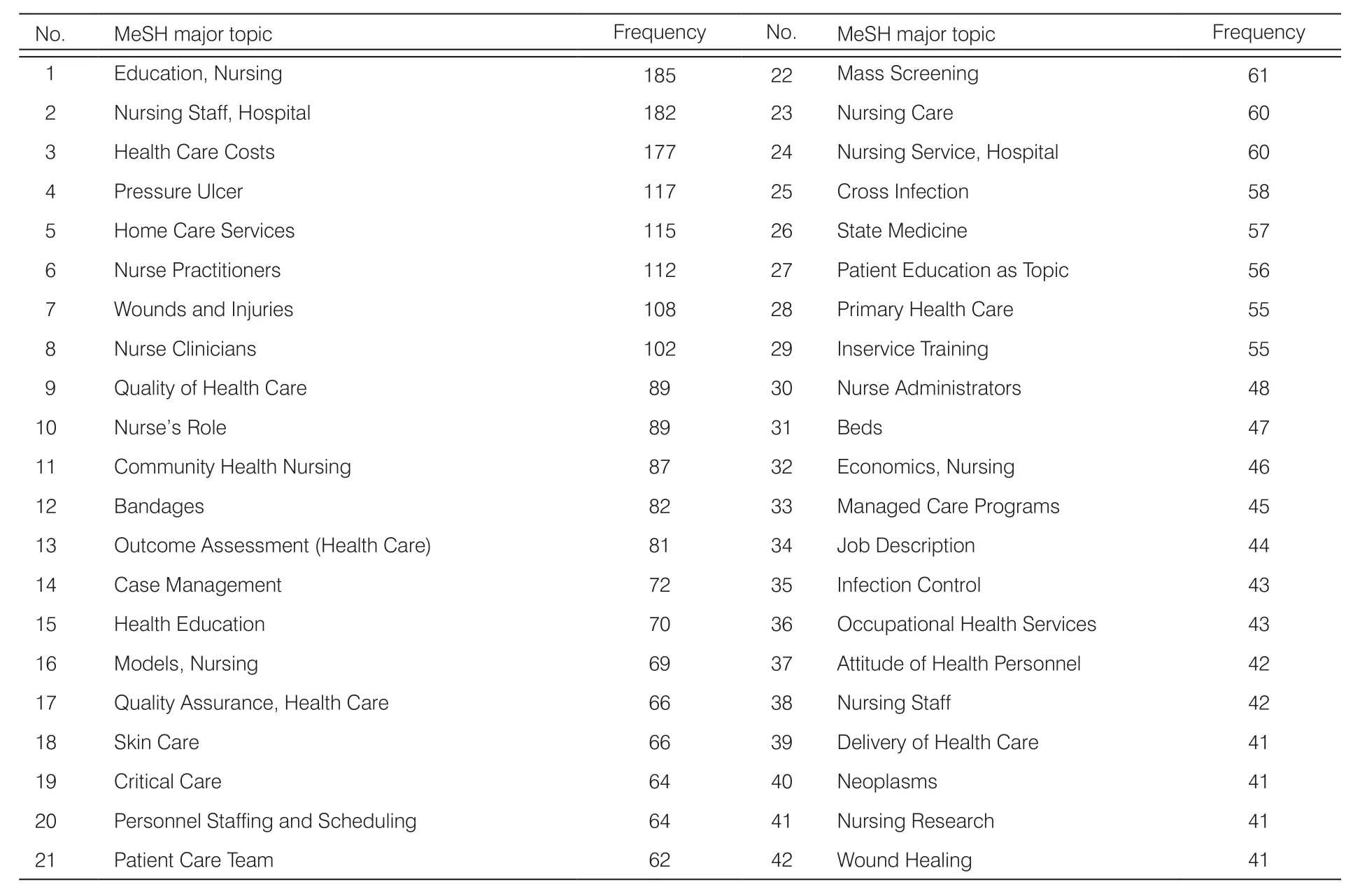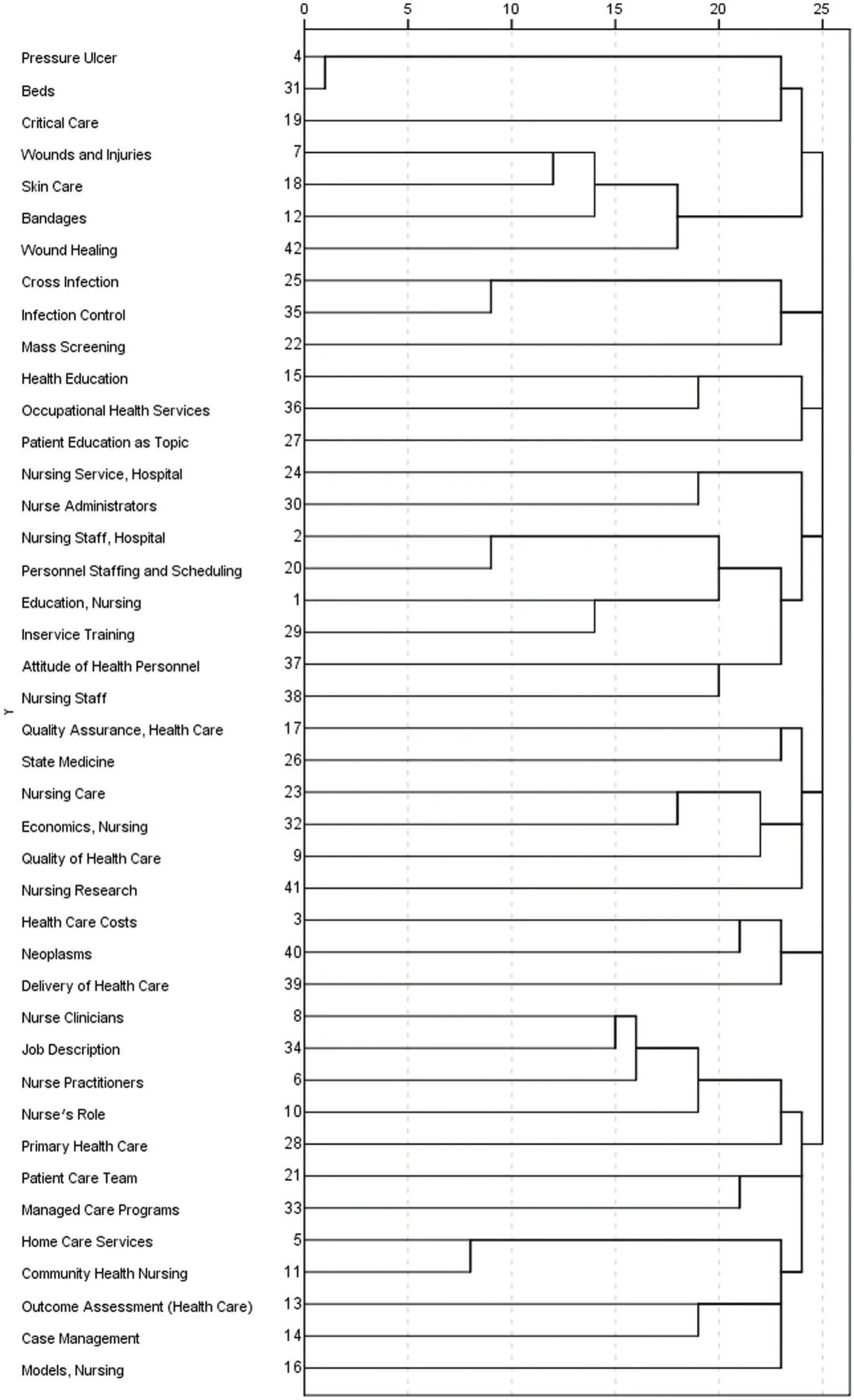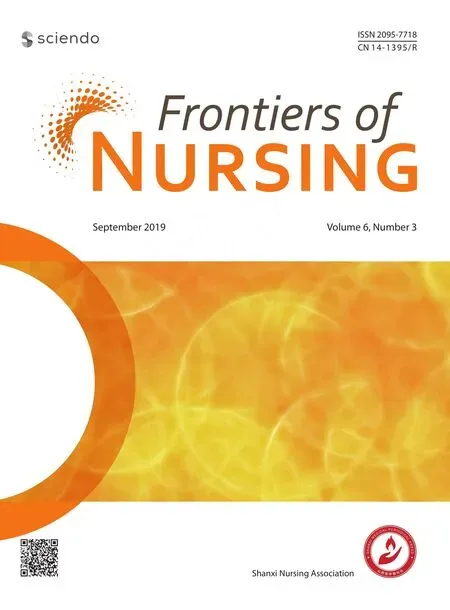Research status and hotspots of economic evaluation in nursing by co-word clustering analysis
Yo-Ji Lio, Guo-Zhen Go
aSchool of Nursing, Guangzhou Medical University, Guangzhou, Guangdong, China
bDepartment of Nursing, The First Aff i liated Hospital of Guangzhou Medical University, Guangzhou, Guangdong, China
Abstract: Objective: The aim of this study is to discover research status and hotspots of economic evaluation (EE) in nursing area using co-word cluster analysis.Methods: Medical Subject Heading (MeSH) term “cost-benef i t analysis” was searched in PubMed and nursing journals were limited by the function of fi lter. The information of author, country, year, journal, and keywords of collected paper was extracted and exported to Bicomb 2.0 system, where high-frequency terms and other data could be further mined. SPSS 19.0 was used for cluster analysis to generate dendrogram.Results: In all, 3,020 articles were found and 10,573 MeSH terms were detected; among them, 1,909 were MeSH major topics and generated 42 high-frequency terms. The consequence of dendrogram showed seven clusters, representing seven research hotspots:skin administration, infection prevention, education program, nurse education and management, EE research, neoplasm patient, and extension of nurse function.Conclusions: Nursing EE research involved multiple aspects in nursing area, which is an important indicator for decision-making.Although the number of papers is increasing, the quality of study is not promising. Therefore, further study may be required to detect nurses' knowledge of economic analysis method and their attitude to apply it into nursing research. More nursing economics course could carry out in nursing school or hospitals.
Keywords: cost-benef i t analysis · co-word clustering analysis · economic evaluation · nursing · nursing education
1. Introduction
As people's multiple demands for health care are growing, the discussion about optimization and allocation of nursing resource continues.1How to balance the limited nursing resources with the required quality of care becomes a problem for hospital and government administrators. If they are making a decision to implement only one of the projects or a project costlier than the traditional one, the difficulty would be much bigger. One of the instruments can help in the selection process of alternative policies, programs, projects, or regulations in health economic evaluation (EE). Health EE is def i ned as the comparative analysis of alternative courses of action in terms of both their costs and consequences.2It is a decision-making process that can provide comparative data to evaluate “choices,” helping policymakers to determine the most cost-effective option for allocation.3Cost-effectiveness analysis, costutility analysis, and cost-benef i t analysis are common methods used in EE. To date, the results of nursing EE have been widely used in nursing practice and management, helping nurse to select effective interventions,4evaluating the cost-effectiveness of healthcare program,5and predicting the availability of human resource management plan.6Currently, nursing EE is playing more and more important role in nursing area. More scholars would participate in the study of nursing costbenef i t analysis. Therefore, the aim of our study is to apply co-word cluster analysis to discover the research status and hotspots of nursing EE so as to provide more references for further research.
2. Methods
2.1. Search strategy
PubMed was the most popular and widely used database, comprising more than 28 million citations for biomedical literature from MEDLINE, life science journals,and online books. Medical Subject Heading (MeSH)term was a controlled vocabulary to index articles in MEDLINE.7They were assigned to each document not only based on the abstract and/or the title but also based on the context of the whole document; thus, they contain high-density information from the document.8“Cost-Benef i t Analysis” was fi rst introduced as a MeSH term in 1976. Any papers included terms, such as “Cost Utility Analysis,” “Economic Evaluation,” and “Cost Effectiveness Analysis,” could also be found using “Cost-Benef i t Analysis.” We did not use other terms like “economic”or “cost” because their results included some studies that just simply calculate the healthcare cost instead of applying EE methods. Therefore, “Cost-Benef i t Analysis” was searched as a MeSH term in PubMed up to May 2, 2018. We also used the function of fi lter to limit the journal category in nursing. All papers we found were included.
2.2. Data extraction and processing
The data of title, author, country, language, year, and MeSH terms of the searching papers were exported in XML format. The XML fi le was processed in Bicomb 2.0,9which is a text mining system to investigate the co-occurrence of bibliographic data in literature. The frequencies of title, author, country, language, year,and MeSH terms were accumulated and the connections between each paper were investigated through their MeSH terms. Statistical data were recorded in the system window and could be exported to Excel.To make the results more focused, the following words were combined or transformed, as they have hierarchical relationship based on MeSH Tree Structure.First, “Hospital Costs” and “Drug Cost” were merged into “Health Care Costs.” Second, “Health Promotion”was merged into “Health Education.” Third, “Education,Nursing, Associate,” “Education, Nursing, Baccalaureate,” “Education, Nursing, Continuing,” “Education,Nursing, Diploma Programs,” and “Education, Nursing, Graduate” were all merged into “Education, Nursing.” We also delete “Cost-Benef i t Analysis” which is a search term that without ref l ecting any research topics. Demarcation of high- and low-frequency terms was calculated using the formula10:where I1 represents the amount of terms whose frequency was 1.
2.3. Data analysis
Co-word matrix of high-frequency terms was produced by Bicomb 2.0. Hierarchical cluster analysis in SPSS 19.0 was used to analyze these data. Cluster method chose “Between-group linkage” and measure chose“binary: Ochiai” to generate Dendrogram.
3. Results
3.1. Results of high-frequency terms
We found 3,020 articles and they were published from 28 different countries, 91% of them from United States(1,973), England (722), and Canada (53). A total of 368 nursing journals were discovered. The top three were Nursing Economic and The Journal of Nursing Administration with 111 published papers and Infection Control and Hospital Epidemiology with 100. In total,10,573 MeSH terms were detected in all the papers but 1,909 MeSH major topics were used to produce the highfrequency terms. The threshold value was 41 based on the formula calculation. Therefore, 42 high-frequency terms were obtained, accounting for 29.7% of the total(Table 1). The term “Education, Nursing” has the highest frequency of 185 and the second is “Nursing Staff,Hospital” of 182.
3.2. Results of hierarchical cluster analysis
Dendrogram is shown in Figure 1. Based on the structure of dendrogram and professional knowledge, seven clusters representing seven research topics were classif i ed and named. Details of each topic name and its terms are shown in Table 2. The smallest group contains three terms and the largest group has 11 terms.

Table 1. Summary of all high-frequency terms.
4. Discussion
Seven clusters representing seven research topics were determined by statistical data and expertise.
4.1. Nursing EE on skin administration
Hospital-acquired skin breakdown usually caused high economic burden on healthcare system.11EE is helpful to discover much cost-effective nursing interventions in skin administration. Hotspots of this class of study focused on the comparison of different intervention and products to prevent pressure ulcers or fasten wound healing. For example, a study showed that nutritional support was cost saving and gained 0.005 quality-adjusted life years compared with standard care to prevent pressure ulcers.12Another study found that a novel soluble beta-glucan gel has a shorter healing time that leads to cost saving over an annual budget cycle of £503 per patient, compared with methylcellulose dressing.13With a deep understanding of the mechanism of wounds and the discovery of innovative products or equipment, this study will continue.
4.2. Nursing EE on infection prevention
Three terms, “cross infection,” “infection control,”and “mass screening,” in this group indicate that the search topic is about infection prevention. Healthcareassociated infections (HAIs) are infections that patients get while receiving treatment for medical or surgical conditions. It is estimated that HAI led to costs of more than $100 million in one state of United States in 2009.14In a study, seven strategies were found to be available to standard precautions in ICU, but based on the method of EE, the author found universal decolonization was the best choice because it was least expensive but moderately effective.15Mass screening is a way for infection prevention. However, by EE, a study showed us that even though a universal methicillin-resistant Staphylococcus aureus (MRSA) screening may provide potential benef i t in preventing MRSA infection, it is relatively costly and may be economically burdensome for a hospital.16

Figure 1. Dendrogram of cluster analysis.

Table 2. Topics and their terms.
4.3. Nursing EE on education program
According to the MeSH terms def i nition in PubMed,“Health Education” means education that increases the awareness and favorably inf l uences the attitudes and knowledge relating to the improvement of health on a personal or community basis; “Occupational Health Services” means health services for employees, usually provided by the employer at the place of work; and “Patient Education as Topic” means the teaching or training of patients concerning their own health needs. They all conveyed the topic of education on both health person and patient. People with chronic disease and employee in hospital or other place are main study participants. The cost-effectiveness ratios and cost per quality-adjusted life year were commonly used as evaluation indicators.Cost-benef i t analysis supports the more widespread implementation of some education program,17and also justify some programs are not cost-effective which should be further developed and modif i ed.18
4.4. Nursing EE on nurse education and management
The terms in this study group include “Education, Nursing” and “Nursing Staff, Hospital” which rank top two of all key terms, indicating nursing education and management is the most popular research topic in EE. Nursing staff education and training is determined by management department of hospital, so these two kinds of studies would have strong connections. Improving the educational level of nurse means hospital has to pay more salaries for them, but unknowing whether the outcome can overweigh its cost. Therefore, this group of studies was to detect the economic value of nursing education. On the one hand, evidence added by empirical study, they have found increasing the baccalaureate nurses' (BSN) dose to 80% for every patient could potentially result in $5.6 million in savings annually that would more than offset annual costs of about$1.8 million in increased salaries associated with BSN qualif i cations.19On the other hand, management department tries to detect more efficient way to quantify the value that nursing professional development brings to the organization20and explored more undiscovered resource to assist nurses. For example, they found providing training curricula to non-nursing staff to provide feeding assistance for nutritionally at-risk nursing home(NH) residents is cost-effective and has a positive effect on residents' between-meal intake.21
4.5. Exploration of EE research in nursing fi eld
Classifying this group of studies is difficult because it included the terms, such as “health care,” “Quality Assurance, Health Care,” and “Nursing Care,” which lack specif i c content. But we can think that the goal of EE is to improve the quality of health care. Therefore, we def i ned this topic according to the terms “nursing research” and“state medicine.” Mark advocated using cost- effectiveness analysis for nursing research and believed the information provided by CEA will be an important additional component of the evidence produced by nursing research.22Wendy systematically reviewed papers about EEs in nursing-relevant research performed in the United States between 1997 and 2015. She found that evaluation indicators in these studies are not standardized and EEs have not been fully utilized in US nursing-related studies over the past two decades.23Studies in this group gave us the importance of EE in nursing research and we should correctly use economic analytical tools in researching.
4.6. Nursing EE on care for neoplasm patient
New drugs and treatment improved the survival rates of various cancers, resulting in the soaring costs of innovative technique and service needs to the increasing number of cancer survivors.24,25EE was served to fi nd cost-effective care program or screening project for survivors. For example, Gordon found a telephonedelivered multiple health behavior change intervention that costs less but can improve physical activity, diet,and weight management.26Groton selected colonoscopy bowel preparation protocols for colorectal cancer patients based on effectiveness, tolerability, and cost.27
4.7. Nursing EE on extension of nurse function
The topic of this group is to investigate the economic value and clinical outcome by expanding nurse's function. Two terms “Nurse Clinicians” and “Nurse Practitioners” can be seen in this group, they are considered advanced practice nurse, who has acquired the expert knowledge base, complex decision-making skills,and clinical competencies for expanded practice.28They expanded their function in an alternative role for physician and complementary role for registered nurse.29Therefore, EE was produced to test whether they really could help to relieve workforce shortage,reduce cost, and improve care quality. At the same time, systematic review revealed that studies about the cost-effectiveness of advanced nurse are of poor methodological quality, indicating that higher quality studies are required.30From the terms “Patient Care Team” and“Case Management,” we can see a new nursing model is developing. “Primary Health Care,” “Home Care Services,” and “Community Health Nursing” showed us that nursing workplace is not restricted in hospital and their role is extended to community and home. These new care models need economic analysis to evaluate their effectiveness, so they become a study topic in EE.
5. Conclusions
Through co-word cluster analysis, we found the hotspots of research in nursing EE focus on the following topics: skin administration, infection prevention,education program, nurse education and management,EE research, neoplasm patient, and extension of nurse function. Although the amounts of papers are increasing, the quality of study is not promising. Therefore, further study may be required to detect nurses' knowledge of economic analysis method and their attitude to apply it into nursing research. Schools in developed countries have already set up some nursing economics courses,but the coverage rate is not high. Maybe that is the main reason for underutilization of EE in nursing research and the malpractice to use it. In the future, it might be possible to set up more nursing economics courses in more schools or hospitals.
Limitation
We used fi lter function in PubMed to limit the journal category in nursing, but probably excluded some related papers published in other types of journals, which may lead to a small bias in our results.
Ethics approval
Not declared.
Conf l icts of interest
All contributing authors declare no conf l icts of interest.
- Frontiers of Nursing的其它文章
- Inf l uence of physical self and mindfulness on the academic possible selves of freshman nursing students
- Analysis of the application and practice of PDCA cycle in management of the naked medicine dispensing—the quality and safety of the drug
- The effect of empowerment education on depression level and laboratory indicators of patients treated with hemodialysis: a meta-analysis
- Investigation and analysis of attitudes and knowledge of aging among students in different majors
- Effectiveness of integrated nursing interventions for fatigue in patients with advanced cancer: a systematic review of randomized controlled trials
- The eligibility criteria, training content, and scope of practice for prescriptive authority for midwives: a modif i ed Delphi study†

